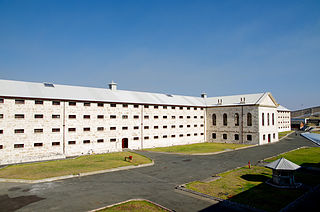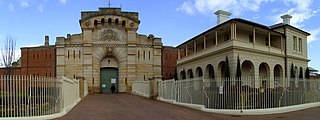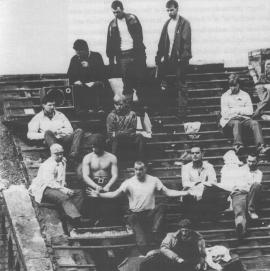Related Research Articles

The Attica Prison Riot, also known as the Attica Prison Rebellion, the Attica Uprising, or the Attica Prison Massacre, took place at the state prison in Attica, New York; it started on September 9, 1971, and ended on September 13 with the highest number of fatalities in the history of United States prison uprisings. Of the 43 men who died, all but one guard and three inmates were killed by law enforcement gunfire when the state retook control of the prison on the final day of the uprising. The Attica Uprising has been described as a historic event in the prisoners' rights movement.

The New Mexico State Penitentiary riot, which took place on February 2 and 3, 1980, at the Penitentiary of New Mexico (PNM) south of Santa Fe, was the most violent prison riot in U.S. history. Inmates took complete control of the prison and twelve officers were taken hostage. Several inmates were killed by other prisoners, with some being tortured and mutilated because they had previously acted as informants for prison authorities. Police regained control of PNM 36 hours after the riots had begun. By then, thirty-three inmates had died and more than two hundred were treated for injuries. None of the twelve officers taken hostage were killed, but seven suffered serious injuries caused by beatings and rapes.

The Long Bay Correctional Complex, commonly called Long Bay, is a correctional facility comprising a heritage-listed maximum and minimum security prison for males and females and a hospital to treat prisoners, psychiatric cases and remandees, located in Malabar, Sydney, New South Wales, Australia. The complex is located approximately 14 kilometres (8.7 mi) south of the Sydney CBD and is contained within a 32-hectare (79-acre) site. The facility is operated by Corrective Services New South Wales, a department administered by the Government of New South Wales.

The former Grafton Gaol, later called the Grafton Correctional Centre and then Grafton Intake and Transient Centre is a heritage-listed former medium security prison for males and females, located in Grafton, Clarence Valley Council, New South Wales, Australia. The centre was operated by Corrective Services NSW an agency of the Department of Attorney General and Justice of the Government of New South Wales. In its last correctional use, the centre detained sentenced and unsentenced felons under New South Wales and/or Commonwealth legislation. It was added to the New South Wales State Heritage Register on 2 April 1999.
Parklea Correctional Centre, a privately managed Australian maximum and minimum security prison for males, is located at Parklea, in the north-western suburbs of Sydney, New South Wales. The facility is operated by MTC Ventia and has a current capacity for 1,350 inmates. The Centre accepts prisoners charged and convicted under New South Wales and/or Commonwealth legislation and incorporates a minimum-security work-release centre for inmates nearing release with a capacity of 120. A Compulsory Drug Treatment Correctional unit is incorporated within the centre.

The Goulburn Correctional Centre, is an Australian supermaximum security prison for males. It is located in Goulburn, New South Wales, three kilometres north-east of the central business district. The facility is operated by Corrective Services NSW. The Complex accepts prisoners charged and convicted under New South Wales and/or Commonwealth legislation and serves as a reception prison for Southern New South Wales, and, in some cases, for inmates from the Australian Capital Territory.

Fremantle Prison, sometimes referred to as Fremantle Gaol or Fremantle Jail, is a former Australian prison and World Heritage Site in Fremantle, Western Australia. The site includes the prison cellblocks, gatehouse, perimeter walls, cottages, and tunnels. It was initially used for convicts transported from Britain, but was transferred to the colonial government in 1886 for use for locally-sentenced prisoners. Royal Commissions were held in 1898 and 1911, and instigated some reform to the prison system, but significant changes did not begin until the 1960s. The government department in charge of the prison underwent several reorganisations in the 1970s and 1980s, but the culture of Fremantle Prison was resistant to change. Growing prisoner discontent culminated in a 1988 riot with guards taken hostage, and a fire that caused $1.8 million worth of damage. The prison closed in 1991, replaced by the new maximum-security Casuarina Prison.

Bathurst Correctional Centre, originally built as Bathurst Gaol in 1888, is a prison for men and women located in the city of Bathurst, New South Wales, Australia, and operated by the Department of Communities and Justice. Bathurst holds inmates sentenced under State or Australian criminal law, along with a small number of remand prisoners.

The Old Maitland Gaol, also known as Maitland Correctional Centre, is a heritage-listed former Australian prison located in East Maitland, New South Wales. Its construction was started in 1844 and prisoners first entered the gaol in 1848. By the time of its closure, on 31 January 1998, it had become the longest continuously-run gaol in Australia. It has since been turned into a museum and is a popular tourist attraction. It was added to the New South Wales State Heritage Register on 2 April 1999.
HM Prison Birmingham is a Category B men's prison in the Winson Green area of Birmingham, England, operated by HM Prison and Probation Service.

The Berrima Correctional Centre is an Australian prison, located at Berrima, New South Wales. The Centre was operational between 1839 and 2011 with a number of breaks in between, and was re-opened in September 2016. Initially established as Berrima Gaol, the facility closed in 1909 and reopened in 1949 as the Berrima Training Centre. The Centre is the oldest Australian correctional facility in operation. It was added to the New South Wales State Heritage Register on 2 April 1999.
Pontiac Correctional Center, established in June 1871, is an Illinois Department of Corrections maximum security prison for adult males in Pontiac, Illinois. The prison also has a medium security unit that houses medium to minimum security inmates and is classified as Level 3. Until the 2011 abolition of the death penalty in Illinois, the prison housed male death row inmates, but had no execution chamber. Inmates were executed at the Tamms Correctional Center. Although the capacity of the prison is 2172, it has an average daily population of approximately 2000 inmates.

The 1990 Strangeways Prison riot was a 25-day prison riot and rooftop protest at Strangeways Prison in Manchester, England. The riot began on 1 April 1990 when prisoners took control of the prison chapel, and quickly spread throughout most of the prison. The incident ended on 25 April when the final five prisoners were removed from the rooftop. One prisoner was killed during the riot, and 147 prison officers and 47 prisoners were injured. Much of the prison was damaged or destroyed, with the cost of repairs coming to £55 million. It was the longest prison riot in British penal history.
Corrective Services New South Wales (CSNSW) is a division of the Department of Communities and Justice of the Government of New South Wales, Australia. CSNSW is responsible for the state's prisons and a range of programs for managing offenders in the community. The state has 36 prisons, 33 run by CSNSW and three privately operated. The agency traces its origins back to 1788, when New South Wales was founded as a penal colony.
Michael Robert Yabsley is an Australian former politician. He was a Liberal member of the New South Wales Legislative Assembly, representing the electorates of Bligh from 1984 to 1988 and Vaucluse from 1988 to 1994.
The British Columbia Penitentiary was a federal maximum security prison located in New Westminster, British Columbia, Canada. The BC Penitentiary operated for 102 years, from 1878 until it was decommissioned in 1980. It was the first federal penal institution west of Manitoba. The Gatehouse was sold on September 8,2021 and was renamed Governors Castle by new owners. Colliers international Appraised the Building at $8,950,000, additional open space for $4,500,00, totalling $13,450,000 at time of purchase by Governors Court Inc.
The history of Fremantle Prison, a former Australian prison in Fremantle, Western Australia, extends from its construction as a prison for convicts, using convict labour, in the 1850s, through to its modern-day usage as a tourist attraction. The design for Fremantle Prison was based on the Pentonville Prison in Britain, and it would be the longest, tallest prison cell block in the southern hemisphere. Construction began in 1851, and was completed by the end of 1859. The prison was transferred to the colonial government in 1886 for use for locally sentenced prisoners. Following a Royal Commission held in 1898−99, some changes were made to Fremantle Prison, including knocking down the inner wall between two cells, introducing a prisoner classification system, and constructing internal walls in the main block to create four separate divisions. A new cell block, New Division, was completed in 1907 and occupied in 1908.
The Honourable John Hailes Flood "Gaffer" Nagle (1913–2009) was a lawyer, soldier and prominent jurist, who served as a justice of the Supreme Court of New South Wales, Australia, from 1960 until 1983. Nagle led high-profile inquiries into the NSW Department of Corrective Services and the assassination of political candidate Donald Mackay.
The Royal Commission into New South Wales Prisons, also known as the Nagle Royal Commission, was established in 1976 to inquire into the management of prisons in the State of New South Wales, Australia. The commission was headed by Supreme Court Justice John Flood Nagle. Nagle's report, handed down in 1978, described "an inefficient Department administering antiquated and disgraceful gaols; untrained and sometimes ignorant prison officers, resentful, intransigent and incapable of performing their tasks." The first of the Royal Commission's 252 recommendations was the dismissal of Corrective Services Commissioner Walter McGeechan – though the Government sacked McGeechan three months before receiving Nagle's final report.
Periodic detention or weekend detention is a type of custodial sentence under which the offender is held in prison between Friday and Sunday evenings each week, but is at liberty at other times. Promoted by prison reformers as an alternative to imprisonment, periodic detention drew praise for allowing offenders to continue working, maintain family relationships, and avoid associating with more dangerous criminals in traditional prisons. It was also considerably less expensive to administer.
References
- ↑ Grabosky, P.N. (1989). Wayward governance: illegality and its control in the public sector.
- ↑ Nagle, John Flood (31 March 1978). Report of the royal commission into New South Wales prisons. New South Wales Government Printer. p. 54.
- ↑ Nagle, John Flood (31 March 1978). Report of the royal commission into New South Wales prisons. New South Wales Government Printer. pp. 56–57.
- ↑ Nagle, John Flood (31 March 1978). Report of the royal commission into New South Wales prisons. New South Wales Government Printer. pp. 55–56.
- ↑ Nagle, John Flood (31 March 1978). Report of the royal commission into New South Wales prisons. New South Wales Government Printer. p. 55.
- ↑ Nagle, John Flood (31 March 1978). Report of the royal commission into New South Wales prisons. New South Wales Government Printer. pp. 58–59.
- ↑ Nagle, John Flood (31 March 1978). Report of the royal commission into New South Wales prisons. New South Wales Government Printer. pp. 58–59.
- ↑ Nagle, John Flood (31 March 1978). Report of the royal commission into New South Wales prisons. New South Wales Government Printer. p. 62.
- ↑ Nagle, John Flood (31 March 1978). Report of the royal commission into New South Wales prisons. New South Wales Government Printer. pp. 62–63.
- ↑ Nagle, John Flood (31 March 1978). Report of the royal commission into New South Wales prisons. New South Wales Government Printer. p. 63.
- ↑ Nagle, John Flood (31 March 1978). Report of the royal commission into New South Wales prisons. New South Wales Government Printer. p. 65.
- ↑ Nagle, John Flood (31 March 1978). Report of the royal commission into New South Wales prisons. New South Wales Government Printer. pp. 65–66.
- ↑ Nagle, John Flood (31 March 1978). Report of the royal commission into New South Wales prisons. New South Wales Government Printer. p. 67.
- ↑ Nagle, John Flood (31 March 1978). Report of the royal commission into New South Wales prisons. New South Wales Government Printer. p. 68.
- ↑ Nagle, John Flood (31 March 1978). Report of the royal commission into New South Wales prisons. New South Wales Government Printer. p. 84.
- ↑ Nagle, John Flood (31 March 1978). Report of the royal commission into New South Wales prisons. New South Wales Government Printer. pp. 82–83.
- ↑ Nagle, John Flood (31 March 1978). Report of the royal commission into New South Wales prisons. New South Wales Government Printer. pp. 86–87.
- ↑ Nagle, John Flood (31 March 1978). Report of the royal commission into New South Wales prisons. New South Wales Government Printer. p. 91.
- ↑ Nagle, John Flood (31 March 1978). Report of the royal commission into New South Wales prisons. New South Wales Government Printer. pp. 92–93.
- ↑ Nagle, John Flood (31 March 1978). Report of the royal commission into New South Wales prisons. New South Wales Government Printer. pp. 93–96.
- ↑ Nagle, John Flood (31 March 1978). Report of the royal commission into New South Wales prisons. New South Wales Government Printer. p. 99.
- ↑ Nagle, John Flood (31 March 1978). Report of the royal commission into New South Wales prisons. New South Wales Government Printer. pp. 102–103.
- ↑ Nagle, John Flood (31 March 1978). Report of the royal commission into New South Wales prisons. New South Wales Government Printer. pp. 109–112.
- ↑ Nagle, John Flood (31 March 1978). Report of the royal commission into New South Wales prisons. New South Wales Government Printer. pp. 113–116.
- ↑ Nagle, John Flood (31 March 1978). Report of the royal commission into New South Wales prisons. New South Wales Government Printer. p. 116.
- ↑ Nagle, John Flood (31 March 1978). Report of the royal commission into New South Wales prisons. New South Wales Government Printer. p. 116.
- ↑ Nagle, John Flood (31 March 1978). Report of the royal commission into New South Wales prisons. New South Wales Government Printer. p. 116.
- ↑ Nagle, John Flood (31 March 1978). Report of the royal commission into New South Wales prisons. New South Wales Government Printer. pp. 116–117.
- ↑ Nagle, John Flood (31 March 1978). Report of the royal commission into New South Wales prisons. New South Wales Government Printer. p. 117.
- ↑ Nagle, John Flood (31 March 1978). Report of the royal commission into New South Wales prisons. New South Wales Government Printer. p. 119.
- ↑ Nagle, John Flood (31 March 1978). Report of the royal commission into New South Wales prisons. New South Wales Government Printer. p. 120.
- ↑ Nagle, John Flood (31 March 1978). Report of the royal commission into New South Wales prisons. New South Wales Government Printer. pp. 121–123.
- ↑ Nagle, John Flood (31 March 1978). Report of the royal commission into New South Wales prisons. New South Wales Government Printer. pp. 123–124.
- ↑ Nagle, John Flood (31 March 1978). Report of the royal commission into New South Wales prisons. New South Wales Government Printer. p. 124.
- ↑ Nagle, John Flood (31 March 1978). Report of the royal commission into New South Wales prisons. New South Wales Government Printer. pp. 124–125.
- ↑ Nagle, John Flood (31 March 1978). Report of the royal commission into New South Wales prisons. New South Wales Government Printer. pp. 128–129.
- ↑ Prisoners Action Group (1978). "Bathurst gaol and the royal commission into prisons – a summary" (PDF). Alternative Criminology Journal.
- ↑ New South Wales Department of Corrective Services (1976). Report of the Department of Corrective Services for the year ended 30 June 1976 (PDF). New South Wales Government Printer.
- ↑ Nagle, John Flood (31 March 1978). Report of the royal commission into New South Wales prisons. New South Wales Government Printer. p. 77.
- ↑ Nagle, John Flood (31 March 1978). Report of the royal commission into New South Wales prisons. New South Wales Government Printer. p. 71.
- ↑ Nagle, J. F. (31 March 1976). Report of the Royal Commission into New South Wales Prisons. New South Wales Government Printer. p. 462.